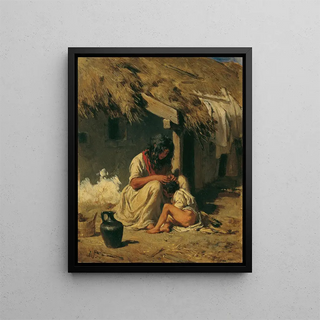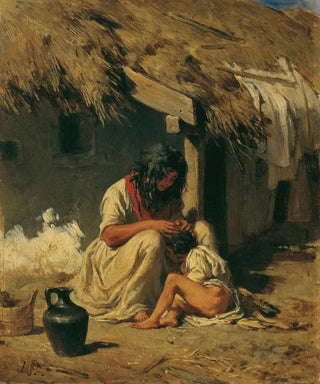Art print | Idylle d'un village hongrois - August von Pettenkofen


View from behind

Frame (optional)
In the rich and vibrant panorama of 19th-century art, the artwork "Idyll of a Hungarian Village" by August von Pettenkofen stands out for its ability to capture the essence of rural life imbued with serenity and simplicity. This painting, which evokes scenes of the Hungarian countryside, transports us to a world where time seems to stand still, where every element of nature and architecture tells a story. Through this art print, the viewer is invited to immerse themselves in a tableau where light, color, and composition combine to create an atmosphere that is both peaceful and poetic.
Style and uniqueness of the work
August von Pettenkofen's work is characterized by a realistic style that masterfully blends meticulous observation of details with an almost impressionist approach to colors and light. In "Idyll of a Hungarian Village," delicate shades of green, blue, and earth tones harmonize to evoke the lush landscapes of Hungary. The characters, depicted in natural and relaxed postures, blend into the scenery, illustrating a daily life filled with gentleness. The artist succeeds in capturing not only the external appearance of the subjects but also the emotion emanating from their interaction with the environment. This work is an ode to the beauty of simple things, a celebration of rural life that still resonates today.
The artist and his influence
August von Pettenkofen, born in 1822 in Vienna, is an emblematic figure of 19th-century Austrian art, whose work was influenced by the Romantic and Realist movements. His passion for landscapes and peasant life led him to explore Hungarian villages, where he drew much of his inspiration. His artistic approach, combining refined technique with a deep sensitivity to nature, left a lasting imprint on his contemporaries and subsequent generations. Pettenkofen transcended his era by offering an authentic and emotive vision of daily life, making him a pioneer in the depiction of rural scenes. His

Matte finish

View from behind

Frame (optional)
In the rich and vibrant panorama of 19th-century art, the artwork "Idyll of a Hungarian Village" by August von Pettenkofen stands out for its ability to capture the essence of rural life imbued with serenity and simplicity. This painting, which evokes scenes of the Hungarian countryside, transports us to a world where time seems to stand still, where every element of nature and architecture tells a story. Through this art print, the viewer is invited to immerse themselves in a tableau where light, color, and composition combine to create an atmosphere that is both peaceful and poetic.
Style and uniqueness of the work
August von Pettenkofen's work is characterized by a realistic style that masterfully blends meticulous observation of details with an almost impressionist approach to colors and light. In "Idyll of a Hungarian Village," delicate shades of green, blue, and earth tones harmonize to evoke the lush landscapes of Hungary. The characters, depicted in natural and relaxed postures, blend into the scenery, illustrating a daily life filled with gentleness. The artist succeeds in capturing not only the external appearance of the subjects but also the emotion emanating from their interaction with the environment. This work is an ode to the beauty of simple things, a celebration of rural life that still resonates today.
The artist and his influence
August von Pettenkofen, born in 1822 in Vienna, is an emblematic figure of 19th-century Austrian art, whose work was influenced by the Romantic and Realist movements. His passion for landscapes and peasant life led him to explore Hungarian villages, where he drew much of his inspiration. His artistic approach, combining refined technique with a deep sensitivity to nature, left a lasting imprint on his contemporaries and subsequent generations. Pettenkofen transcended his era by offering an authentic and emotive vision of daily life, making him a pioneer in the depiction of rural scenes. His






